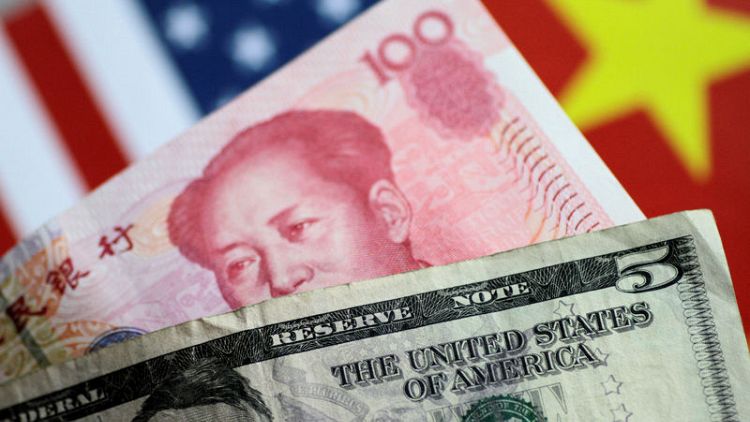(Reuters) - 1/SIXES AND SEVENS
The Sino-U.S. trade war is getting more acrimonious. After China responded to U.S. tariff increases with additional levies of its own, Washington blacklisted telecoms giant Huawei, prompting Chinese state social media to ramp up the war of words. All that's taken the yuan past 6.9 per dollar, despite authorities' efforts to snuff out speculation by adjusting daily exchange rate fixings and draining cash from markets.
But markets seem bent on testing the central bank's resolve not to let the yuan fall too fast and breach the 7-per-dollar level. Given some evidence Beijing has been selling U.S. Treasury bonds in favour of gold, many are wondering if China will use a weaker yuan both as a bargaining chip and a means to offset higher tariffs on its exports. But weaponising the yuan has its downside. Aside from capital flight and the hit to local banks, a yuan plunge will undermine the goal of promoting global yuan use and luring foreign investors to Chinese stocks and bonds.
The 3% yuan plunge so far in May is already putting investors to flight; the Institute of International Finance estimates equity outflows of around $600 million (471 million pounds) a day, totalling $4 billion in the past week and half. Further currency weakening may bring more of the same.
-China evokes patriotism, past wars as trade conflict with U.S. heats up--China's cbank will not let yuan decline past 7 to the dollar – sources –
For a graphic on China's falling yuan approaches 7/dollar, see - https://tmsnrt.rs/2W6Aoqb
2/TRADE BLIPS ON FED'S RADAR
The Federal Reserve seems so far to have discounted the trade war as something that could derail economic expansion. The words "trade" and "tariffs" get no mention in Fed statements, and Chairman Jerome Powell didn't dwell on them in his latest post-meeting address.
But minutes of the April 30-May 1 meeting, due on Wednesday, could show if the escalating noise figured in the Fed's discussions. Since the meeting, tariffs have been ratcheted higher by the White House and Beijing, triggering a global equity market selloff.
The S&P 500 has fallen about 2% since its May 1 record high, and on May 13 it suffered one of its biggest percentage drops of the year. Risk-off rotation into bonds has pushed 10-year yields 15 basis points lower this month, and part of the yield curve has inverted - a possible harbinger of recession.
Fed presidents from Richmond, Boston and Minneapolis have expressed concern whether a drawn out trade conflict that hurts the economy, might require a policy response. Interest rate futures are pricing in a 51% chance the Fed would lower its rate target in September. For December it's 73%.
- Fed's Barkin watching effect of U.S.-China trade dispute on business confidence
-Fed officials see risks in weaker inflation expectations, trade row
For a graphic on S&P 500 vs 10-year US Treasury yield, see - https://tmsnrt.rs/2W29mAx
3/EUROSCEPTICS AT THE GATES
It's the biggest democratic exercise after India's general elections, with 400 million people eligible to vote -- European Union citizens go to the polls on May 23-26 to elect 751 lawmakers to the EU parliament. It could turn out to be a defining moment for the "Europe project".
At a time of worsening income inequality and sluggish economic growth, anti-establishment and eurosceptic parties are widely expected make a strong showing. From Matteo Salvini's League in Italy to Marine le Pen's National Assembly in France and Nigel Farage's Brexit party in Britain, their agenda is to slow European integration and return power to national capitals.
At the Europe-wide level, these groups are likely to hamper -- but not derail -- approval of the next European Commission president and budget. National-level effects may be greater. A drubbing for Britain's ruling Conservatives could accelerate Prime Minister Theresa May's exit and raise chances of 'no deal' Brexit. A strong showing for Italy's League may embolden Salvini to dissolve the coalition government and call new elections.
A better-than-expected outcome for the far-right will be bad news for the euro and sterling.
-Duelling in the dark: EU candidates pitch to (some) voters
-Game on for EU vote, but real fight comes after
For a graphic on European elections, see - https://tmsnrt.rs/2EdJ1W2
4/LET'S TALK SHOPS
U.S. consumer goods companies, a sector that includes retailers, have reported stellar Q1 results -- I/B/E/S Refinitiv data shows more than 80% delivered consensus-busting earnings. But an unexpected fall in U.S. retail sales last month has raised question marks over consumer resilience. So with big-name department and chain stores Home Depot, Kohl's, Nordstrom, and Target due to report results in coming days, investors will monitor what the firms say about the outlook.
Their rivals Walmart and Macy's have already brought the market down to earth; while earnings beat forecasts, both retailers warned of damage to sales and rising prices due to the U.S.-China trade spat. The reality check came after the White House lifted tariffs on $200 billion of Chinese imports, including suitcases, electronics and clothing to 25% from 10%.
The warnings also undermined President Donald Trump's assertion that China would pick up the tab for his tariff campaign, not American consumers. A hit to the retail sector will pose risks to growth in the world's No. 1 economy. And while U.S. equities have rocketed to record highs this year, shares in many department stores are sharply lower.
-Walmart says higher China tariffs will increase prices for U.S. shoppers
-Macy's CEO says tariff escalation could hurt business
-ANALYSIS-Trump's tariff push squeezes businesses and consumers
For a graphic on U.S. retailers, see - https://tmsnrt.rs/2EaVeKY
5/WATCH YOUR PMIS
It has been a dismal few months for the global economy with the trade conflict sending a frisson through markets and chilling business activity across the world. Europe in particular has seen its recovery sputter and Germany's industrial sector -- the continent's engine room -- has actually gone into reverse.
Some hope returned this past week, with data showing Germany returning to growth in the first quarter of 2019 and boosting the entire single currency bloc. But bond markets are on edge and not just in Europe: German 10-year yields are deeply negative again and the recent inversion of part of the U.S. Treasury curve has raised recession fears.
Hence, the close focus on upcoming purchasing managers' indexes; compiler Markit gives us a flash glimpse on May 23. But as far as European business surveys are concerned, Reuters polls are not encouraging; expectations are German manufacturing PMIs will clock in at 45 and the euro zone equivalent at 48.2; well below the 50 mark that separates expansion from contraction.
The U.S. survey is due the same day. Business sentiment in the world's largest economy has been a bit healthier, with a reading of 53 last month. But with Sino-U.S. trade tensions simmering, there are no guarantees on this score either.
-POLL-U.S. recession risk rises as U.S.-China trade tensions heat up
-Money market bets on euro zone rate cut by year-end on the rise
-Euro zone economy accelerates in Q1 as Germany rebounds
For a graphic on German industrial production, see - https://tmsnrt.rs/2M3Uq15
(Reporting by Sujata Rao, Josephine Mason and Abhinav Ramnarayan in London; Alden Bentley in New York and Vidya Ranganathan in Singapore; Editing by Toby Chopra)



